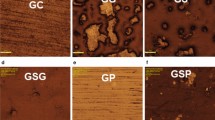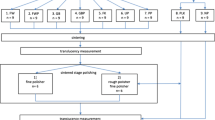Abstract
Objectives
There is insufficient information about the effects of the thickness of externally characterized stains or glazes on CIELAB color parameters and the translucency parameter (TP) of 5 mol% yttria partially stabilized zirconia (5Y-PSZ). The present study evaluated the effect of a thickness reduction of the externally characterized or glazed layer on its CIE2000 color parameters and TP00 of 5Y-PSZ.
Materials and methods
Twenty-eight specimens were sectioned from 5Y-PSZ blanks. Three brands of powdered stains (namely VI, SH, and IV) and a glaze (GL) were used to extrinsically stain the specimen surfaces (n = 7 per group). After measuring the final thickness and color, specimens of each group were carefully ground and finally polished. The reduced thickness was carefully controlled in decrements of 0.02 mm on the characterized stains or glazed layers at each reduction cycle until the surface of the un-stained zirconia was exposed. The CIELAB color parameters of specimens were measured using a spectrophotometer. Subsequently, differences in lightness (∆L′), chroma (∆C′), and hue (∆H′), and TP00 values and color differences (ΔE00) were calculated using the CIEDE2000 formula to determine differences between the specimen and the un-stained zirconia at each reduction cycle. A paired-samples t-test, two-way mixed-design analysis of variance, and Pearson correlation coefficient were used to analyze the data (α = 0.05).
Results
There were no significant differences in lightness, chroma, hue, or TP00 values before or after glazing or after each reduction cycle of the glazed layer. Mean ΔE00 values ranged between 20.94 and 33.55 after applying the externally characterized stains. With a decreased thickness of the characterized stain layer, there were observed that significant decreases in ∆L′, ∆H′, ∆C′, and ΔE00, and significant increases in TP00.
Conclusions
Increasing the thickness of externally characterized stains decreased the lightness and caused the alternation of chroma and hue, whereas these phenomena were not observed in the glazed group. There was a slight change of CIE2000 color parameters and TP00 when the thickness of the characterized layer exceeded 0.06 mm.
Clinical relevance
The application and thickness of externally characterized stains can sensitively affect CIE2000 color parameters and translucency of 5Y-PSZ.

Similar content being viewed by others
References
Zarone F, SimonaSorrentino R (2011) From porcelain-fused-to-metal to zirconia: clinical and experimental considerations. Dent Mater 27:83–96
Tzanakakis E, Tzoutzas I, Kontonasaki E (2013) Zirconia: contemporary views of a much talked material: Structure, applications and clinical considerations. Hellenic Stomatolog Rev 57:101–137
Kurt M, Turhan B (2019) Effects of accelerated artificial aging on the translucency and color stability of monolithic ceramics with different surface treatments. J Prosthet Dent 121:712. e1-712. e8
Koçak EF, Uçar Y, Kurtoğlu C, Johnston WM (2019) Color and translucency of zirconia infrastructures and porcelain-layered systems. J Prosthet Dent 121:510–516
Yuan JC-C, Ricardo VA, Wee AG, Alfaro MF, Afshari FS, Sukotjo C (2018) Effect of brushing and thermocycling on the shade and surface roughness of CAD-CAM ceramic restorations. J Prosthet Dent 119:1000–1006
Garza LA, Thompson G, Cho S-H, Berzins DW (2016) Effect of toothbrushing on shade and surface roughness of extrinsically stained pressable ceramics. J Prosthet Dent 115:489–494
Lee W-F, Sheng-WeiLu Y-J, Hsin-JuiPeng P-W (2016) Effects of two surface finishes on the color of cemented and colored anatomic-contour zirconia crowns. J Prosthet Dent 116:264–268
Kim H-K, Sung-Hun (2014) Effect of the number of coloring liquid applications on the optical properties of monolithic zirconia. Dent Mater 30:e229–e237
Wang F, Takahashi H, Iwasaki N (2013) Translucency of dental ceramics with different thicknesses. J Prosthet Dent 110:14–20
Kim H-K, Sung-HunLee J-B, Jung-SukYeo I-S (2013) Effect of polishing and glazing on the color and spectral distribution of monolithic zirconia. J Adv Prosthodont 5:296–304
Bai Y, Zhao J, Si W, Wang X (2016) Two-body wear performance of dental colored zirconia after different surface treatments. J Prosthet Dent 116:584–590
Manziuc MM, Gasparik C, Burde AV, Colosi HA, Negucioiu M, Dudea D (2019) Effect of glazing on translucency, color, and surface roughness of monolithic zirconia materials. J Esthet Restor Dent 31:478–485
Ahangari AH, TorabiMahdavi K, FaridehArdakani MT (2015) The effect of two shading techniques on value of zirconia-based crowns. J Dent 16:129
Zhang Y, Lawn BR (2018) Novel zirconia materials in dentistry. J Dent Res 97:140–147
Mao L, Kaizer MR, Zhao M, Guo B, Song YF, Zhang Y (2018) Graded ultra-translucent zirconia (5Y-PSZ) for strength and functionalities. J Dent Res 97:1222–1228
Yu N-K, Mi-Gyoung (2019) Effect of different coloring liquids on the flexural strength of multilayered zirconia. J Adv Prosthodont 11:209–214
Shen J, Xie H, Wu X, Yang J, Liao M, Chen C (2020) Evaluation of the effect of low-temperature degradation on the translucency and mechanical properties of ultra-transparent 5Y-TZP ceramics. Ceram Int 46:553–559
Sen N, Isler S (2020) Microstructural, physical, and optical characterization of high-translucency zirconia ceramics. J Prosthet Dent 123:761–768
Alp G, Subaşı MG, Seghi RR, Johnston WM, Yilmaz B (2018) Effect of shading technique and thickness on color stability and translucency of new generation translucent zirconia. J Dent 73:19–23
Subaşı MG, Alp G, Johnston WM, Yilmaz B (2018) Effects of fabrication and shading technique on the color and translucency of new-generation translucent zirconia after coffee thermocycling. J Prosthet Dent 120:603–608
Zhang F, Van Meerbeek B, Vleugels J (2020) Importance of tetragonal phase in high-translucent partially stabilized zirconia for dental restorations. Dent Mater 36:491–500
Stawarczyk B, Keul C, Eichberger M, Figge D, Edelhoff D, Lümkemann N (2017) Three generations of zirconia: from veneered to monolithic. Part I Quintessence Int 48:369–380
Stawarczyk B, Keul C, Eichberger M, Figge D, Edelhoff D, Lümkemann N (2017) Three generations of zirconia: from veneered to monolithic. Part II Quintessence Int 48:441–450
Tabatabaian F, Motamedi E, Sahabi M, Torabzadeh H, Namdari M (2018) Effect of thickness of monolithic zirconia ceramic on final color. J Prosthet Dent 120:257–262
Kim H-K, Kim S-H, Lee J-B, Han J-S, Yeo I-S, Ha S-R (2016) Effect of the amount of thickness reduction on color and translucency of dental monolithic zirconia ceramics. J Adv Prosthodont 8:37–42
Too TDC, Inokoshi M, Nozaki K, Shimizubata M, Nakai H, Liu H, Minakuchi S (2021) Influence of sintering conditions on translucency, biaxial flexural strength, microstructure, and low-temperature degradation of highly translucent dental zirconia. Dent Mater J 40:1320–1328
Bittar BF, Miranda JS, Simões AC, de Carvalho RN, Machado JP, Zhang Y, Souza ROA, Leite FPP (2019) Effect of extrinsic pigmentation and surface treatments on biaxial flexure strength after cyclic loading of a translucent ZrO2 ceramic. Dent Mater 35:1644–1653
Volpato CÂM, Cesar PF, Bottıno MA (2016) Influence of accelerated aging on the color stability of dental zirconia. J Esthet Restor Dent 28:304–312
Farzin M, Ansarifard E, Taghva M, Imanpour R (2021) Effect of external staining on the optical properties and surface roughness of monolithic zirconia of different thicknesses. J Prosthet Dent 126:687. e1-687. e8
Lee W-F, Iwasaki N, Peng P-W, Takahashi H (2022) Effect of toothbrushing on the optical properties and surface roughness of extrinsically stained high-translucency zirconia. Clin Oral Invest 26:3041–3048
Paravina RD, Ghinea R, Herrera LJ, Bona AD, Igiel C, Linninger M, Sakai M, Takahashi H, Tashkandi E, Mar Perez Md (2015) Color difference thresholds in dentistry. J Esthet Restor Dent 27:S1–S9
Sharma G, Wu W, Dalal EN (2005) The CIEDE2000 color-difference formula: Implementation notes, supplementary test data, and mathematical observations. Color Research & Application: Endorsed by Inter-Society Color Council, The Colour Group (Great Britain) Canadian Society for Color, Color Science Association of Japan, Dutch Society for the Study of Color, The Swedish Colour Centre Foundation, Colour Society of Australia, CentreFrançais de la Couleur 30 21 30
CIE (2004) Colorimetry technical report. Book title. Bureau Central de la CIE Vienna,
Baldissara P, Llukacej A, Ciocca L, Valandro FL, Scotti R (2010) Translucency of zirconia copings made with different CAD/CAM systems. J Prosthet Dent 104:6–12
Paravina RD, Pérez MM, Ghinea R (2019) Acceptability and perceptibility thresholds in dentistry: a comprehensive review of clinical and research applications. J Esthet Restor Dent 31:103–112
Salas M, Lucena C, Herrera LJ, Yebra A, Della Bona A, Pérez MM (2018) Translucency thresholds for dental materials. Dent Mater 34:1168–1174
Author information
Authors and Affiliations
Contributions
We-Fang Lee: methodology, validation, investigation, writing—original draft, visualization; Naohiko Iwasaki: validation, resources; Pei-Wen Peng: methodology, investigation, formal analysis, data curation, writing—review and editing, visualization; Hidekazu Takahashi: conceptualization, writing—review and editing, supervision, conceptualization.
Corresponding author
Ethics declarations
Ethical approval
This article contains no studies with human participants or animals performed by any of the authors.
Informed consent
For this type of study, formal consent was not required.
Conflict of interest
The authors declare no competing interests.
Additional information
Publisher's note
Springer Nature remains neutral with regard to jurisdictional claims in published maps and institutional affiliations.
Rights and permissions
Springer Nature or its licensor holds exclusive rights to this article under a publishing agreement with the author(s) or other rightsholder(s); author self-archiving of the accepted manuscript version of this article is solely governed by the terms of such publishing agreement and applicable law.
About this article
Cite this article
Lee, WF., Takahashi, H., Iwasaki, N. et al. Effect of thickness of externally characterized stains on optical properties of high-translucency zirconia. Clin Oral Invest 27, 165–171 (2023). https://doi.org/10.1007/s00784-022-04704-6
Received:
Accepted:
Published:
Issue Date:
DOI: https://doi.org/10.1007/s00784-022-04704-6




